Management Theory and Practices of the organization
VerifiedAdded on 2023/05/28
|12
|2393
|145
AI Summary
The paper evaluates the role of leadership, management and power in driving organizations towards success and attaining competitive advantage in the market. It provides comprehensive insights of the role of HRM and leadership techniques in organizations functioning in competitive market.
Contribute Materials
Your contribution can guide someone’s learning journey. Share your
documents today.
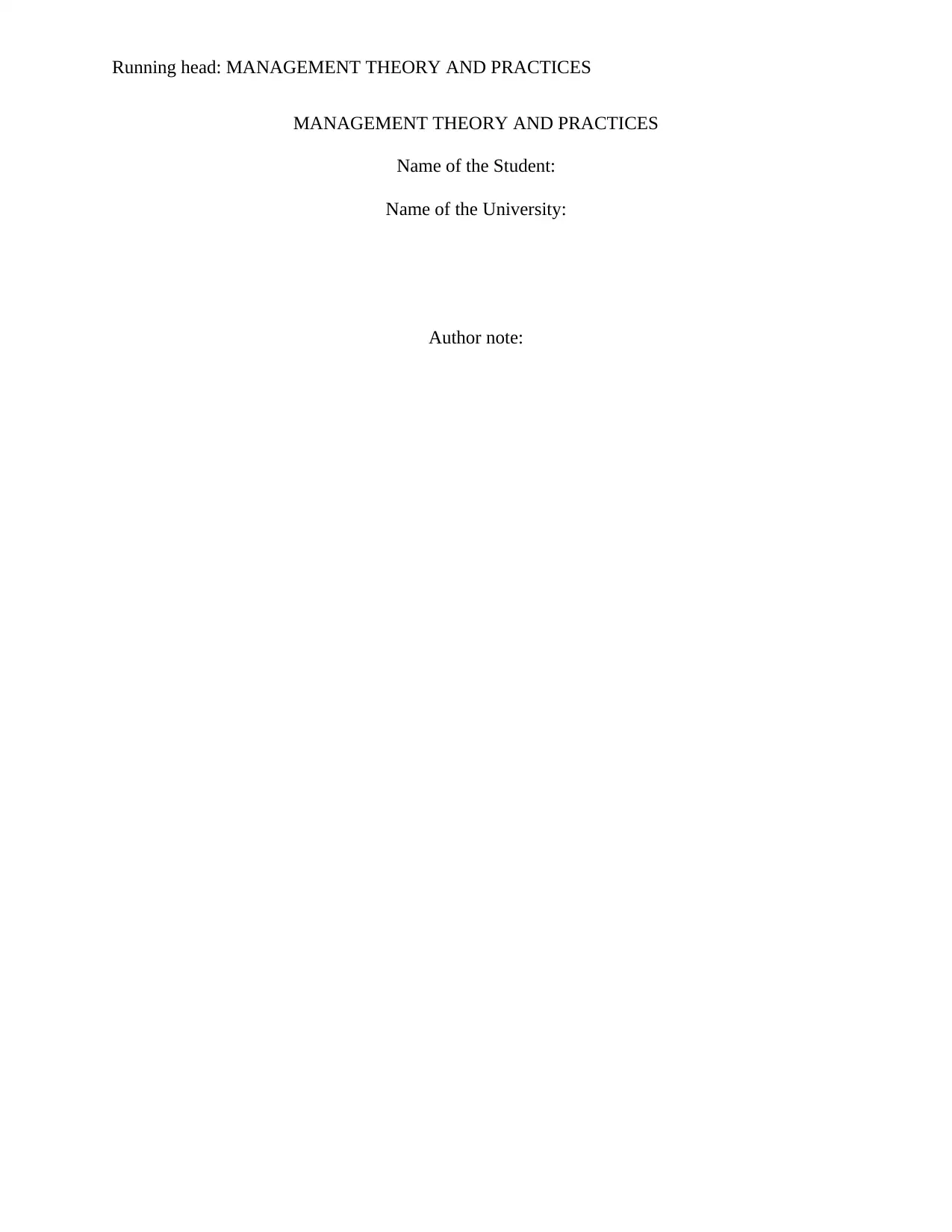
Running head: MANAGEMENT THEORY AND PRACTICES
MANAGEMENT THEORY AND PRACTICES
Name of the Student:
Name of the University:
Author note:
MANAGEMENT THEORY AND PRACTICES
Name of the Student:
Name of the University:
Author note:
Secure Best Marks with AI Grader
Need help grading? Try our AI Grader for instant feedback on your assignments.
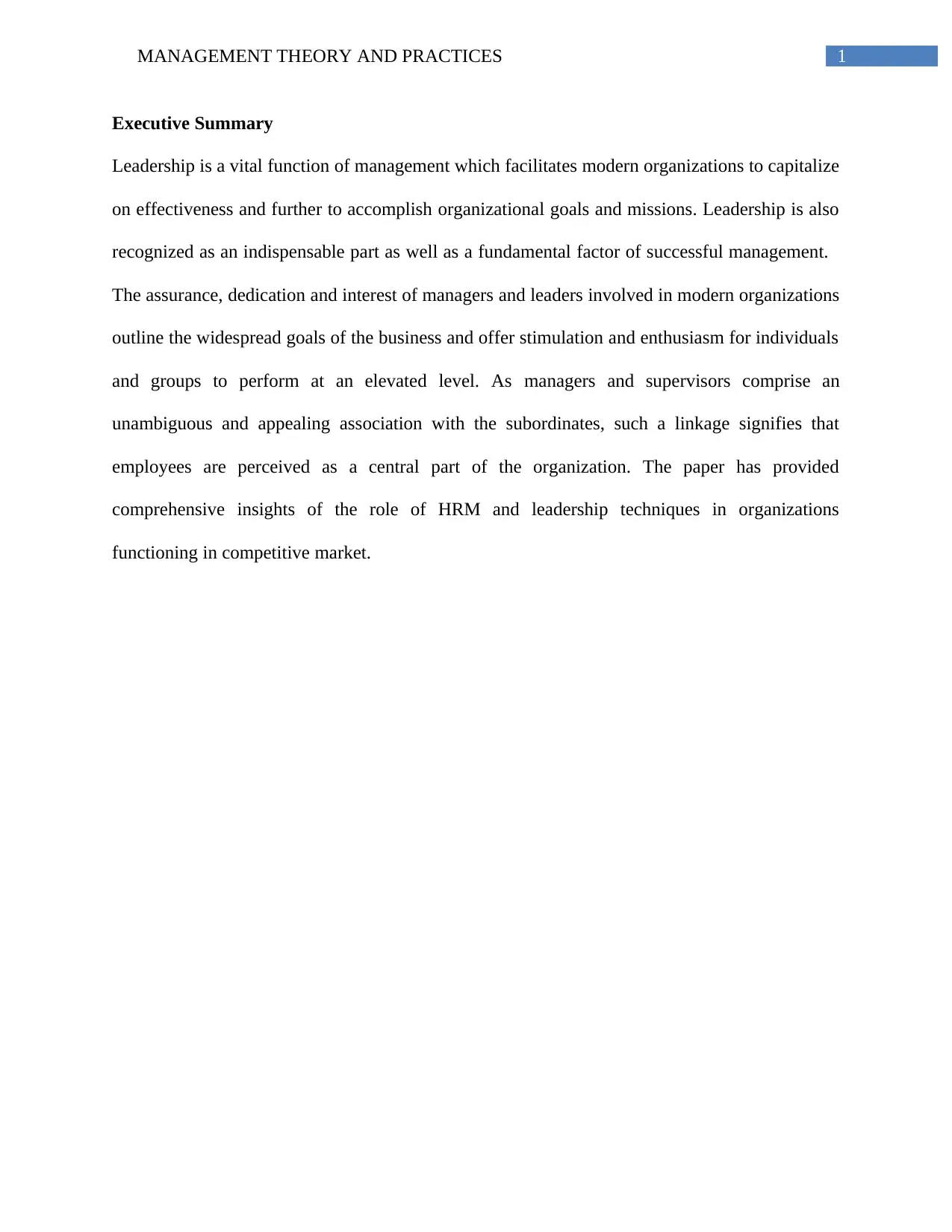
1MANAGEMENT THEORY AND PRACTICES
Executive Summary
Leadership is a vital function of management which facilitates modern organizations to capitalize
on effectiveness and further to accomplish organizational goals and missions. Leadership is also
recognized as an indispensable part as well as a fundamental factor of successful management.
The assurance, dedication and interest of managers and leaders involved in modern organizations
outline the widespread goals of the business and offer stimulation and enthusiasm for individuals
and groups to perform at an elevated level. As managers and supervisors comprise an
unambiguous and appealing association with the subordinates, such a linkage signifies that
employees are perceived as a central part of the organization. The paper has provided
comprehensive insights of the role of HRM and leadership techniques in organizations
functioning in competitive market.
Executive Summary
Leadership is a vital function of management which facilitates modern organizations to capitalize
on effectiveness and further to accomplish organizational goals and missions. Leadership is also
recognized as an indispensable part as well as a fundamental factor of successful management.
The assurance, dedication and interest of managers and leaders involved in modern organizations
outline the widespread goals of the business and offer stimulation and enthusiasm for individuals
and groups to perform at an elevated level. As managers and supervisors comprise an
unambiguous and appealing association with the subordinates, such a linkage signifies that
employees are perceived as a central part of the organization. The paper has provided
comprehensive insights of the role of HRM and leadership techniques in organizations
functioning in competitive market.
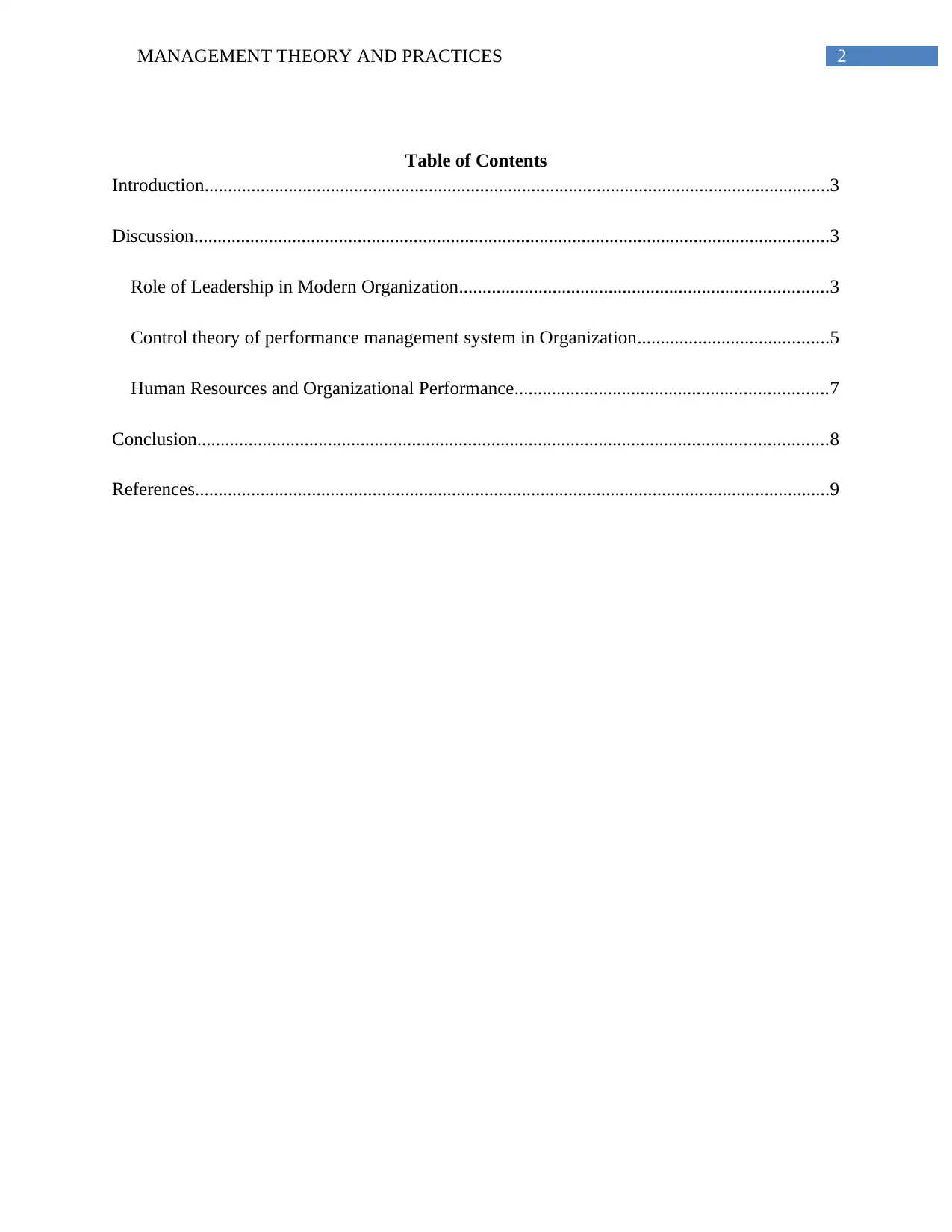
2MANAGEMENT THEORY AND PRACTICES
Table of Contents
Introduction......................................................................................................................................3
Discussion........................................................................................................................................3
Role of Leadership in Modern Organization...............................................................................3
Control theory of performance management system in Organization.........................................5
Human Resources and Organizational Performance...................................................................7
Conclusion.......................................................................................................................................8
References........................................................................................................................................9
Table of Contents
Introduction......................................................................................................................................3
Discussion........................................................................................................................................3
Role of Leadership in Modern Organization...............................................................................3
Control theory of performance management system in Organization.........................................5
Human Resources and Organizational Performance...................................................................7
Conclusion.......................................................................................................................................8
References........................................................................................................................................9

3MANAGEMENT THEORY AND PRACTICES
Introduction
Managers fundamentally aim to influence all phases of modern organizations by
providing organizations with competent and resourceful workforce (Bolman and Deal 2017). The
essential role of managers is to guide organizations towards goal attainment. According to
Bolman and Deal (2017), as majority of modern organizations tend to exist for distinct purposes,
management constitute the accountability for combining and further utilizing organizational
resources in order to ensure successful attainment of organizational goals and missions.
Furthermore, in the view of Palmer, Dunford and Akin (2016), as group performance and team
work play decisive role in realizing organizational goals, leadership becomes immensely vital for
any organization for the proper execution of work. The purpose of the following paper is to
evaluate the role of leadership, management and power in driving organizations towards success
and attaining competitive advantage in the market.
Discussion
Role of Leadership in Modern Organization
Organizations operating in rapidly competitive market do not possess the opulence of
stability because of its growing change in markets, consumers and technology. Thus,
organizations needs to accept and implement changes in the business model by aligning to
shifting developments, technological advancements, consumer preferences and potential
concerns (Palmer, Dunford and Akin 2016). Bennett, Segerberg and Knüpfer (2018) have stated
that the core business of organizations has been continually facing threats from new entrants in
the marketplace who comprise superior and diverse business paradigm. Thus for meeting new
challenges, the customary leadership techniques have evolved whereby line managers have taken
over the role of leadership role. According to Lawson (2015), as leadership is a decisive factor
Introduction
Managers fundamentally aim to influence all phases of modern organizations by
providing organizations with competent and resourceful workforce (Bolman and Deal 2017). The
essential role of managers is to guide organizations towards goal attainment. According to
Bolman and Deal (2017), as majority of modern organizations tend to exist for distinct purposes,
management constitute the accountability for combining and further utilizing organizational
resources in order to ensure successful attainment of organizational goals and missions.
Furthermore, in the view of Palmer, Dunford and Akin (2016), as group performance and team
work play decisive role in realizing organizational goals, leadership becomes immensely vital for
any organization for the proper execution of work. The purpose of the following paper is to
evaluate the role of leadership, management and power in driving organizations towards success
and attaining competitive advantage in the market.
Discussion
Role of Leadership in Modern Organization
Organizations operating in rapidly competitive market do not possess the opulence of
stability because of its growing change in markets, consumers and technology. Thus,
organizations needs to accept and implement changes in the business model by aligning to
shifting developments, technological advancements, consumer preferences and potential
concerns (Palmer, Dunford and Akin 2016). Bennett, Segerberg and Knüpfer (2018) have stated
that the core business of organizations has been continually facing threats from new entrants in
the marketplace who comprise superior and diverse business paradigm. Thus for meeting new
challenges, the customary leadership techniques have evolved whereby line managers have taken
over the role of leadership role. According to Lawson (2015), as leadership is a decisive factor
Secure Best Marks with AI Grader
Need help grading? Try our AI Grader for instant feedback on your assignments.
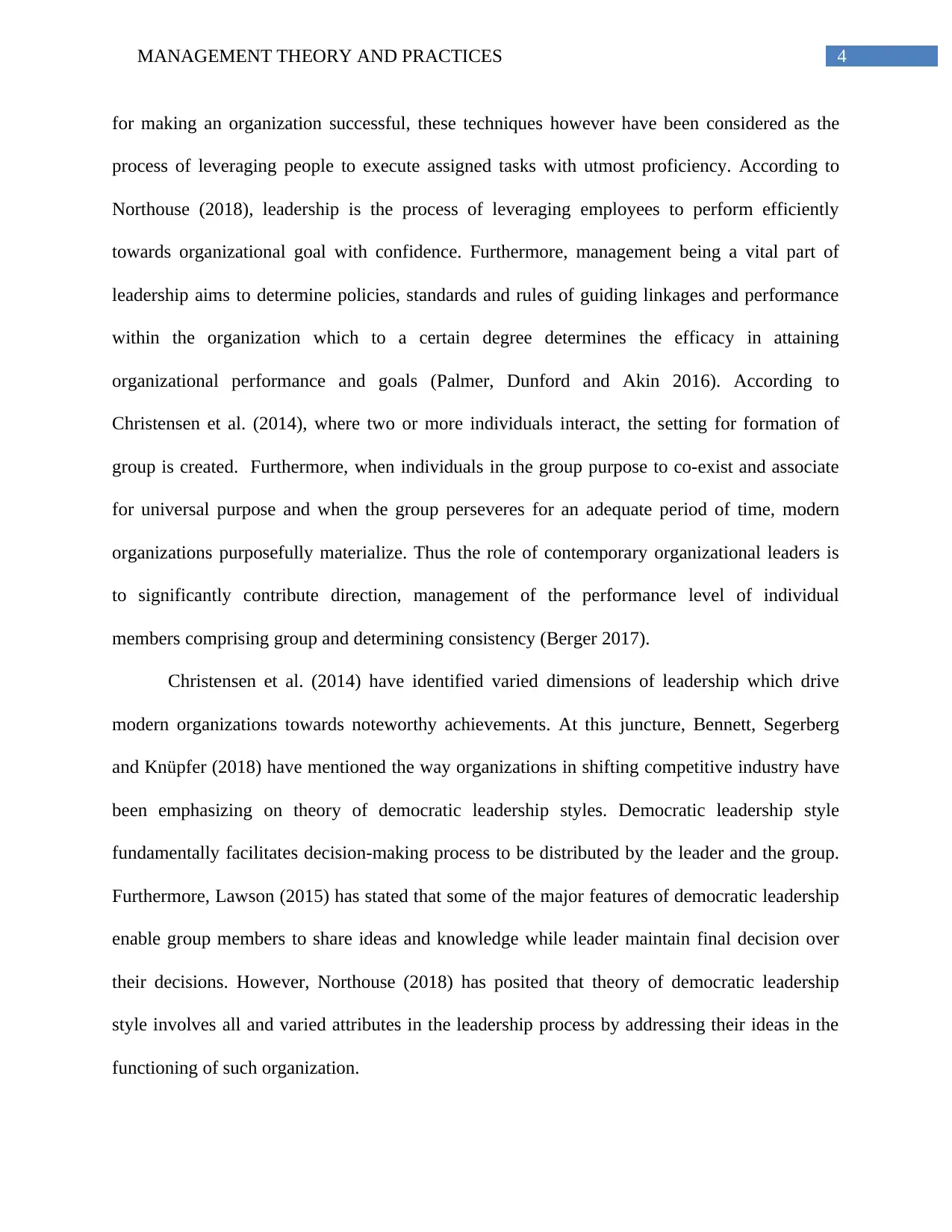
4MANAGEMENT THEORY AND PRACTICES
for making an organization successful, these techniques however have been considered as the
process of leveraging people to execute assigned tasks with utmost proficiency. According to
Northouse (2018), leadership is the process of leveraging employees to perform efficiently
towards organizational goal with confidence. Furthermore, management being a vital part of
leadership aims to determine policies, standards and rules of guiding linkages and performance
within the organization which to a certain degree determines the efficacy in attaining
organizational performance and goals (Palmer, Dunford and Akin 2016). According to
Christensen et al. (2014), where two or more individuals interact, the setting for formation of
group is created. Furthermore, when individuals in the group purpose to co-exist and associate
for universal purpose and when the group perseveres for an adequate period of time, modern
organizations purposefully materialize. Thus the role of contemporary organizational leaders is
to significantly contribute direction, management of the performance level of individual
members comprising group and determining consistency (Berger 2017).
Christensen et al. (2014) have identified varied dimensions of leadership which drive
modern organizations towards noteworthy achievements. At this juncture, Bennett, Segerberg
and Knüpfer (2018) have mentioned the way organizations in shifting competitive industry have
been emphasizing on theory of democratic leadership styles. Democratic leadership style
fundamentally facilitates decision-making process to be distributed by the leader and the group.
Furthermore, Lawson (2015) has stated that some of the major features of democratic leadership
enable group members to share ideas and knowledge while leader maintain final decision over
their decisions. However, Northouse (2018) has posited that theory of democratic leadership
style involves all and varied attributes in the leadership process by addressing their ideas in the
functioning of such organization.
for making an organization successful, these techniques however have been considered as the
process of leveraging people to execute assigned tasks with utmost proficiency. According to
Northouse (2018), leadership is the process of leveraging employees to perform efficiently
towards organizational goal with confidence. Furthermore, management being a vital part of
leadership aims to determine policies, standards and rules of guiding linkages and performance
within the organization which to a certain degree determines the efficacy in attaining
organizational performance and goals (Palmer, Dunford and Akin 2016). According to
Christensen et al. (2014), where two or more individuals interact, the setting for formation of
group is created. Furthermore, when individuals in the group purpose to co-exist and associate
for universal purpose and when the group perseveres for an adequate period of time, modern
organizations purposefully materialize. Thus the role of contemporary organizational leaders is
to significantly contribute direction, management of the performance level of individual
members comprising group and determining consistency (Berger 2017).
Christensen et al. (2014) have identified varied dimensions of leadership which drive
modern organizations towards noteworthy achievements. At this juncture, Bennett, Segerberg
and Knüpfer (2018) have mentioned the way organizations in shifting competitive industry have
been emphasizing on theory of democratic leadership styles. Democratic leadership style
fundamentally facilitates decision-making process to be distributed by the leader and the group.
Furthermore, Lawson (2015) has stated that some of the major features of democratic leadership
enable group members to share ideas and knowledge while leader maintain final decision over
their decisions. However, Northouse (2018) has posited that theory of democratic leadership
style involves all and varied attributes in the leadership process by addressing their ideas in the
functioning of such organization.
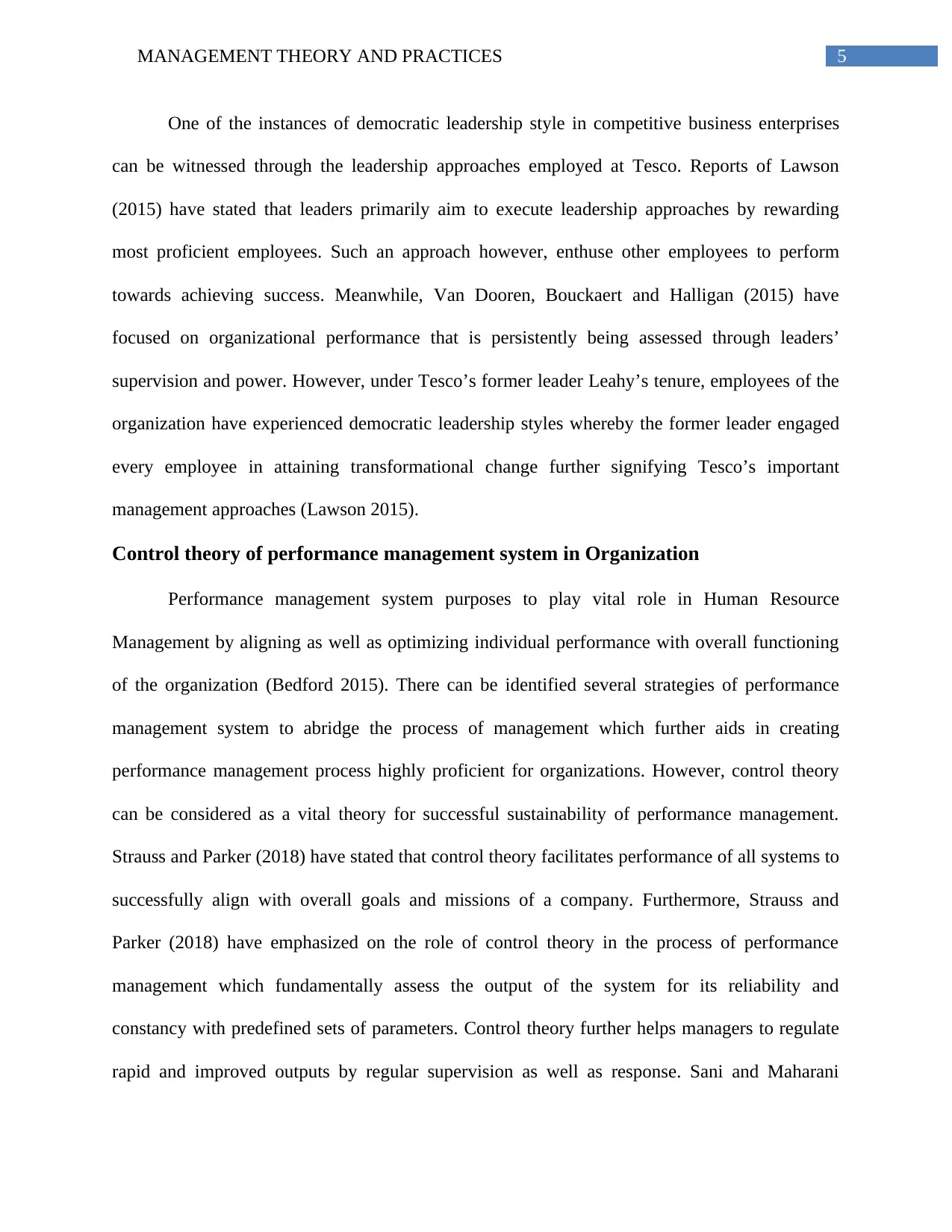
5MANAGEMENT THEORY AND PRACTICES
One of the instances of democratic leadership style in competitive business enterprises
can be witnessed through the leadership approaches employed at Tesco. Reports of Lawson
(2015) have stated that leaders primarily aim to execute leadership approaches by rewarding
most proficient employees. Such an approach however, enthuse other employees to perform
towards achieving success. Meanwhile, Van Dooren, Bouckaert and Halligan (2015) have
focused on organizational performance that is persistently being assessed through leaders’
supervision and power. However, under Tesco’s former leader Leahy’s tenure, employees of the
organization have experienced democratic leadership styles whereby the former leader engaged
every employee in attaining transformational change further signifying Tesco’s important
management approaches (Lawson 2015).
Control theory of performance management system in Organization
Performance management system purposes to play vital role in Human Resource
Management by aligning as well as optimizing individual performance with overall functioning
of the organization (Bedford 2015). There can be identified several strategies of performance
management system to abridge the process of management which further aids in creating
performance management process highly proficient for organizations. However, control theory
can be considered as a vital theory for successful sustainability of performance management.
Strauss and Parker (2018) have stated that control theory facilitates performance of all systems to
successfully align with overall goals and missions of a company. Furthermore, Strauss and
Parker (2018) have emphasized on the role of control theory in the process of performance
management which fundamentally assess the output of the system for its reliability and
constancy with predefined sets of parameters. Control theory further helps managers to regulate
rapid and improved outputs by regular supervision as well as response. Sani and Maharani
One of the instances of democratic leadership style in competitive business enterprises
can be witnessed through the leadership approaches employed at Tesco. Reports of Lawson
(2015) have stated that leaders primarily aim to execute leadership approaches by rewarding
most proficient employees. Such an approach however, enthuse other employees to perform
towards achieving success. Meanwhile, Van Dooren, Bouckaert and Halligan (2015) have
focused on organizational performance that is persistently being assessed through leaders’
supervision and power. However, under Tesco’s former leader Leahy’s tenure, employees of the
organization have experienced democratic leadership styles whereby the former leader engaged
every employee in attaining transformational change further signifying Tesco’s important
management approaches (Lawson 2015).
Control theory of performance management system in Organization
Performance management system purposes to play vital role in Human Resource
Management by aligning as well as optimizing individual performance with overall functioning
of the organization (Bedford 2015). There can be identified several strategies of performance
management system to abridge the process of management which further aids in creating
performance management process highly proficient for organizations. However, control theory
can be considered as a vital theory for successful sustainability of performance management.
Strauss and Parker (2018) have stated that control theory facilitates performance of all systems to
successfully align with overall goals and missions of a company. Furthermore, Strauss and
Parker (2018) have emphasized on the role of control theory in the process of performance
management which fundamentally assess the output of the system for its reliability and
constancy with predefined sets of parameters. Control theory further helps managers to regulate
rapid and improved outputs by regular supervision as well as response. Sani and Maharani
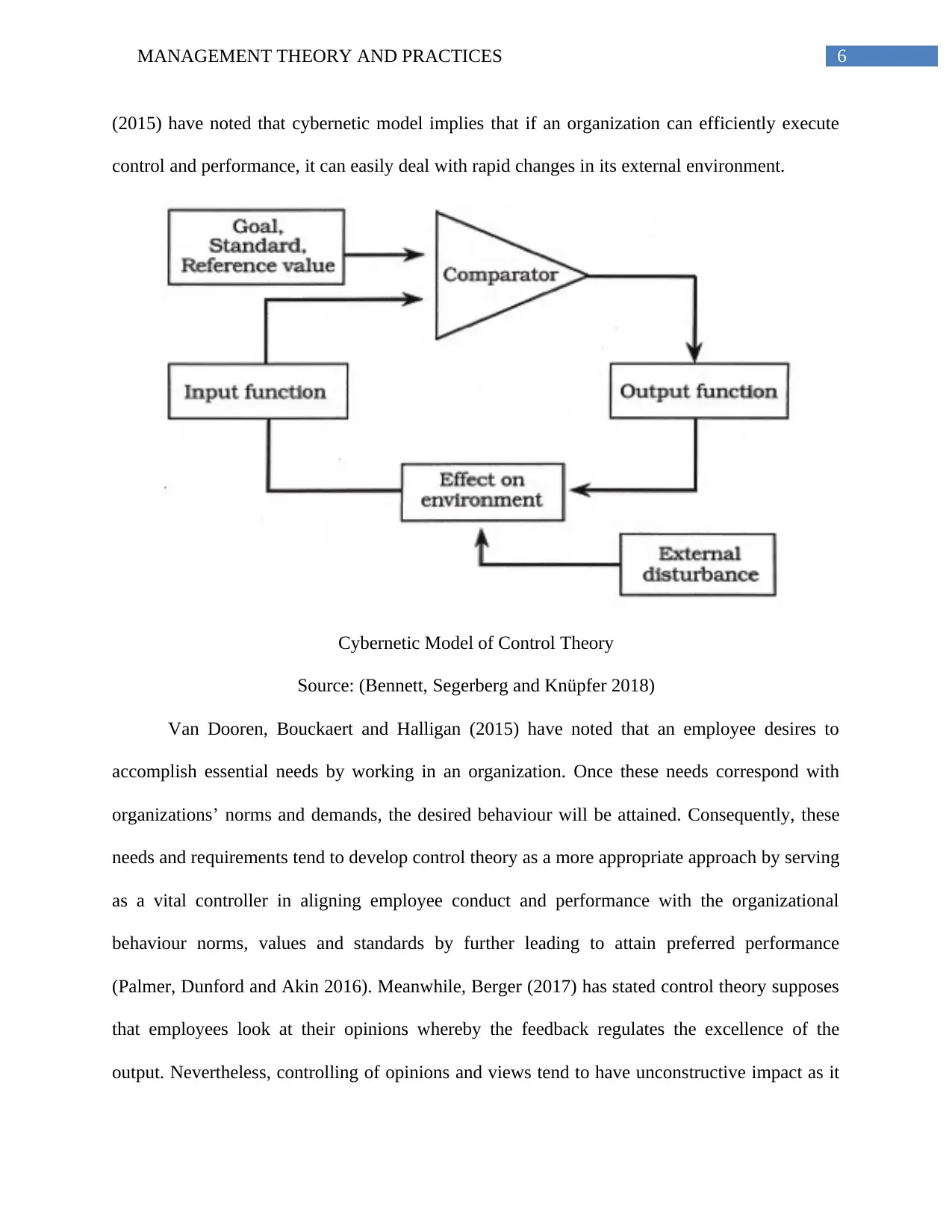
6MANAGEMENT THEORY AND PRACTICES
(2015) have noted that cybernetic model implies that if an organization can efficiently execute
control and performance, it can easily deal with rapid changes in its external environment.
Cybernetic Model of Control Theory
Source: (Bennett, Segerberg and Knüpfer 2018)
Van Dooren, Bouckaert and Halligan (2015) have noted that an employee desires to
accomplish essential needs by working in an organization. Once these needs correspond with
organizations’ norms and demands, the desired behaviour will be attained. Consequently, these
needs and requirements tend to develop control theory as a more appropriate approach by serving
as a vital controller in aligning employee conduct and performance with the organizational
behaviour norms, values and standards by further leading to attain preferred performance
(Palmer, Dunford and Akin 2016). Meanwhile, Berger (2017) has stated control theory supposes
that employees look at their opinions whereby the feedback regulates the excellence of the
output. Nevertheless, controlling of opinions and views tend to have unconstructive impact as it
(2015) have noted that cybernetic model implies that if an organization can efficiently execute
control and performance, it can easily deal with rapid changes in its external environment.
Cybernetic Model of Control Theory
Source: (Bennett, Segerberg and Knüpfer 2018)
Van Dooren, Bouckaert and Halligan (2015) have noted that an employee desires to
accomplish essential needs by working in an organization. Once these needs correspond with
organizations’ norms and demands, the desired behaviour will be attained. Consequently, these
needs and requirements tend to develop control theory as a more appropriate approach by serving
as a vital controller in aligning employee conduct and performance with the organizational
behaviour norms, values and standards by further leading to attain preferred performance
(Palmer, Dunford and Akin 2016). Meanwhile, Berger (2017) has stated control theory supposes
that employees look at their opinions whereby the feedback regulates the excellence of the
output. Nevertheless, controlling of opinions and views tend to have unconstructive impact as it
Paraphrase This Document
Need a fresh take? Get an instant paraphrase of this document with our AI Paraphraser
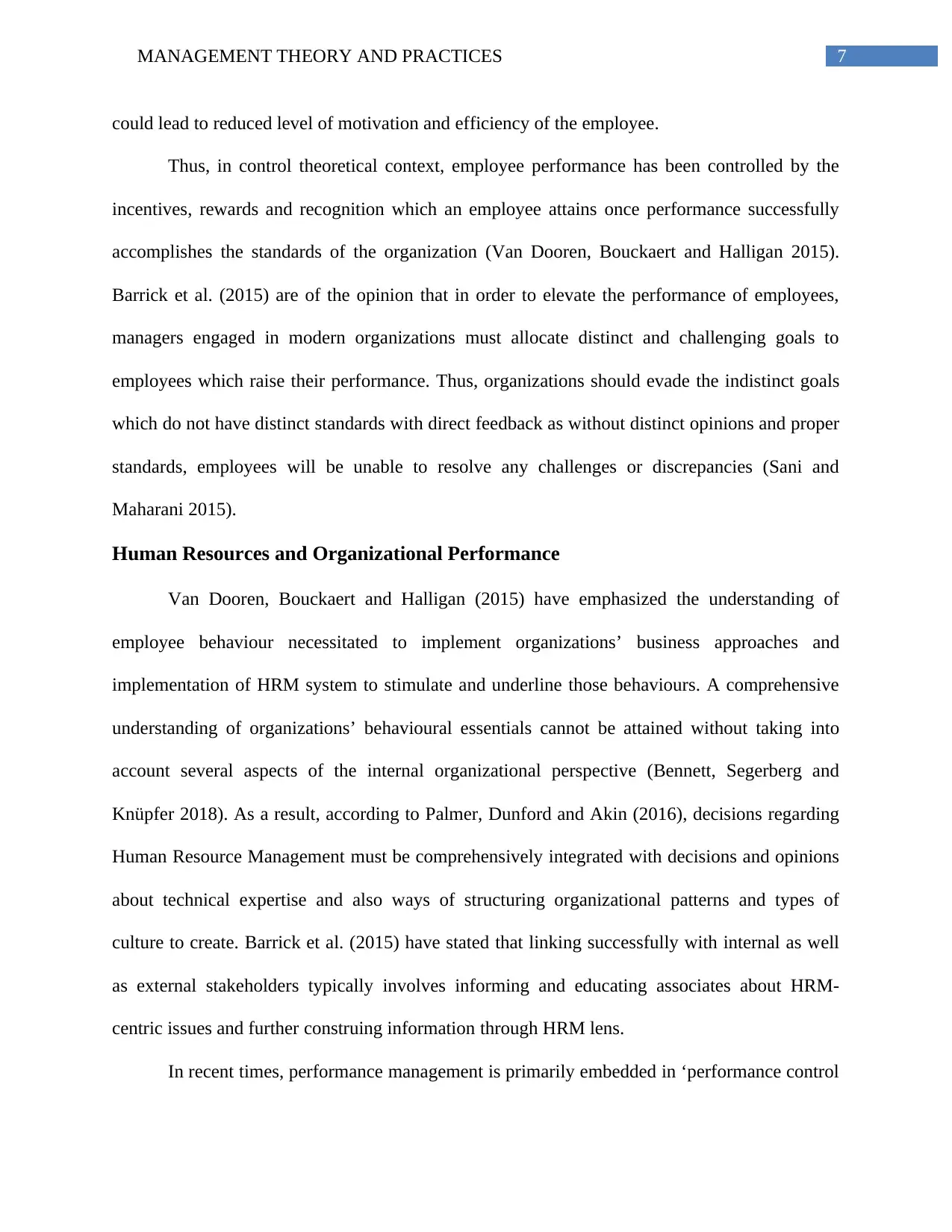
7MANAGEMENT THEORY AND PRACTICES
could lead to reduced level of motivation and efficiency of the employee.
Thus, in control theoretical context, employee performance has been controlled by the
incentives, rewards and recognition which an employee attains once performance successfully
accomplishes the standards of the organization (Van Dooren, Bouckaert and Halligan 2015).
Barrick et al. (2015) are of the opinion that in order to elevate the performance of employees,
managers engaged in modern organizations must allocate distinct and challenging goals to
employees which raise their performance. Thus, organizations should evade the indistinct goals
which do not have distinct standards with direct feedback as without distinct opinions and proper
standards, employees will be unable to resolve any challenges or discrepancies (Sani and
Maharani 2015).
Human Resources and Organizational Performance
Van Dooren, Bouckaert and Halligan (2015) have emphasized the understanding of
employee behaviour necessitated to implement organizations’ business approaches and
implementation of HRM system to stimulate and underline those behaviours. A comprehensive
understanding of organizations’ behavioural essentials cannot be attained without taking into
account several aspects of the internal organizational perspective (Bennett, Segerberg and
Knüpfer 2018). As a result, according to Palmer, Dunford and Akin (2016), decisions regarding
Human Resource Management must be comprehensively integrated with decisions and opinions
about technical expertise and also ways of structuring organizational patterns and types of
culture to create. Barrick et al. (2015) have stated that linking successfully with internal as well
as external stakeholders typically involves informing and educating associates about HRM-
centric issues and further construing information through HRM lens.
In recent times, performance management is primarily embedded in ‘performance control
could lead to reduced level of motivation and efficiency of the employee.
Thus, in control theoretical context, employee performance has been controlled by the
incentives, rewards and recognition which an employee attains once performance successfully
accomplishes the standards of the organization (Van Dooren, Bouckaert and Halligan 2015).
Barrick et al. (2015) are of the opinion that in order to elevate the performance of employees,
managers engaged in modern organizations must allocate distinct and challenging goals to
employees which raise their performance. Thus, organizations should evade the indistinct goals
which do not have distinct standards with direct feedback as without distinct opinions and proper
standards, employees will be unable to resolve any challenges or discrepancies (Sani and
Maharani 2015).
Human Resources and Organizational Performance
Van Dooren, Bouckaert and Halligan (2015) have emphasized the understanding of
employee behaviour necessitated to implement organizations’ business approaches and
implementation of HRM system to stimulate and underline those behaviours. A comprehensive
understanding of organizations’ behavioural essentials cannot be attained without taking into
account several aspects of the internal organizational perspective (Bennett, Segerberg and
Knüpfer 2018). As a result, according to Palmer, Dunford and Akin (2016), decisions regarding
Human Resource Management must be comprehensively integrated with decisions and opinions
about technical expertise and also ways of structuring organizational patterns and types of
culture to create. Barrick et al. (2015) have stated that linking successfully with internal as well
as external stakeholders typically involves informing and educating associates about HRM-
centric issues and further construing information through HRM lens.
In recent times, performance management is primarily embedded in ‘performance control
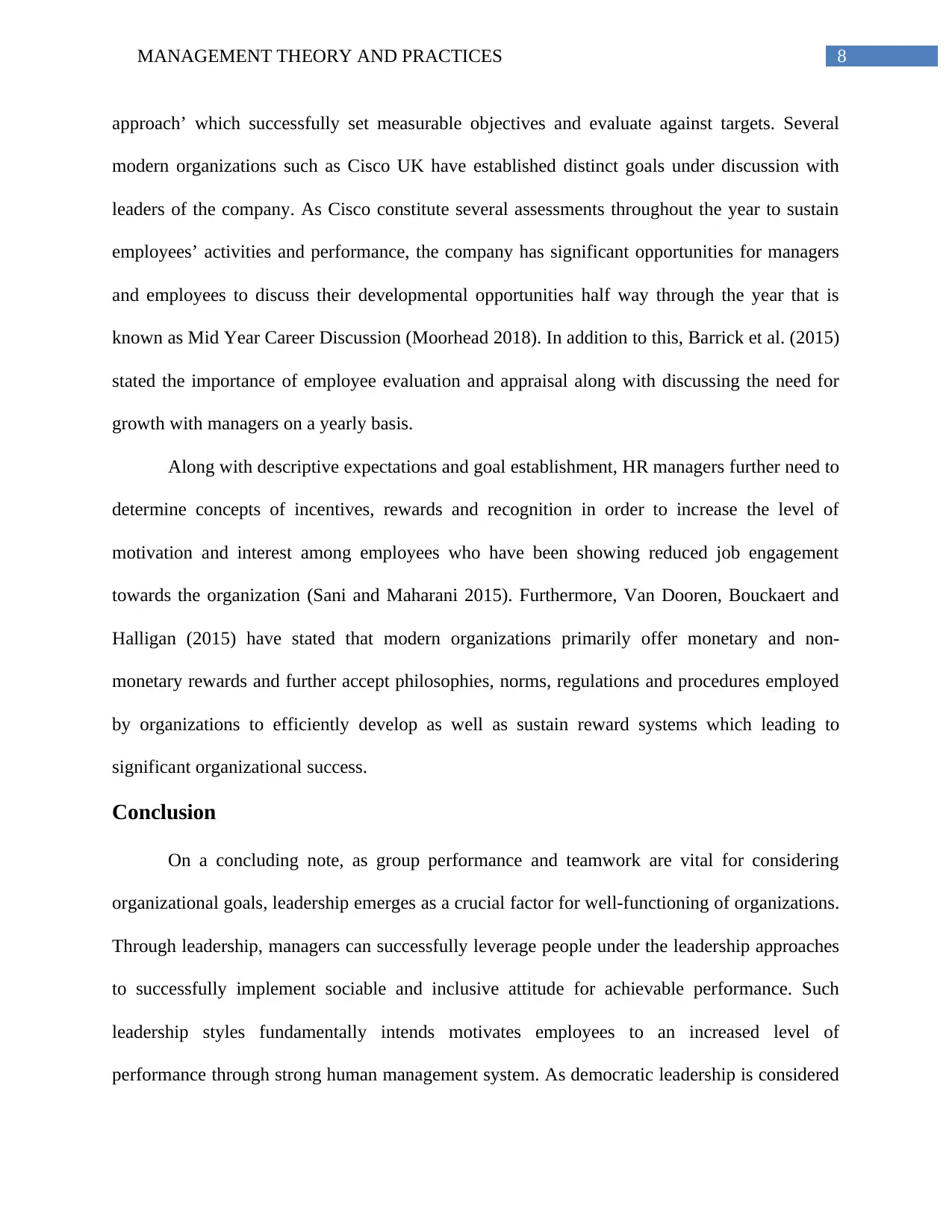
8MANAGEMENT THEORY AND PRACTICES
approach’ which successfully set measurable objectives and evaluate against targets. Several
modern organizations such as Cisco UK have established distinct goals under discussion with
leaders of the company. As Cisco constitute several assessments throughout the year to sustain
employees’ activities and performance, the company has significant opportunities for managers
and employees to discuss their developmental opportunities half way through the year that is
known as Mid Year Career Discussion (Moorhead 2018). In addition to this, Barrick et al. (2015)
stated the importance of employee evaluation and appraisal along with discussing the need for
growth with managers on a yearly basis.
Along with descriptive expectations and goal establishment, HR managers further need to
determine concepts of incentives, rewards and recognition in order to increase the level of
motivation and interest among employees who have been showing reduced job engagement
towards the organization (Sani and Maharani 2015). Furthermore, Van Dooren, Bouckaert and
Halligan (2015) have stated that modern organizations primarily offer monetary and non-
monetary rewards and further accept philosophies, norms, regulations and procedures employed
by organizations to efficiently develop as well as sustain reward systems which leading to
significant organizational success.
Conclusion
On a concluding note, as group performance and teamwork are vital for considering
organizational goals, leadership emerges as a crucial factor for well-functioning of organizations.
Through leadership, managers can successfully leverage people under the leadership approaches
to successfully implement sociable and inclusive attitude for achievable performance. Such
leadership styles fundamentally intends motivates employees to an increased level of
performance through strong human management system. As democratic leadership is considered
approach’ which successfully set measurable objectives and evaluate against targets. Several
modern organizations such as Cisco UK have established distinct goals under discussion with
leaders of the company. As Cisco constitute several assessments throughout the year to sustain
employees’ activities and performance, the company has significant opportunities for managers
and employees to discuss their developmental opportunities half way through the year that is
known as Mid Year Career Discussion (Moorhead 2018). In addition to this, Barrick et al. (2015)
stated the importance of employee evaluation and appraisal along with discussing the need for
growth with managers on a yearly basis.
Along with descriptive expectations and goal establishment, HR managers further need to
determine concepts of incentives, rewards and recognition in order to increase the level of
motivation and interest among employees who have been showing reduced job engagement
towards the organization (Sani and Maharani 2015). Furthermore, Van Dooren, Bouckaert and
Halligan (2015) have stated that modern organizations primarily offer monetary and non-
monetary rewards and further accept philosophies, norms, regulations and procedures employed
by organizations to efficiently develop as well as sustain reward systems which leading to
significant organizational success.
Conclusion
On a concluding note, as group performance and teamwork are vital for considering
organizational goals, leadership emerges as a crucial factor for well-functioning of organizations.
Through leadership, managers can successfully leverage people under the leadership approaches
to successfully implement sociable and inclusive attitude for achievable performance. Such
leadership styles fundamentally intends motivates employees to an increased level of
performance through strong human management system. As democratic leadership is considered
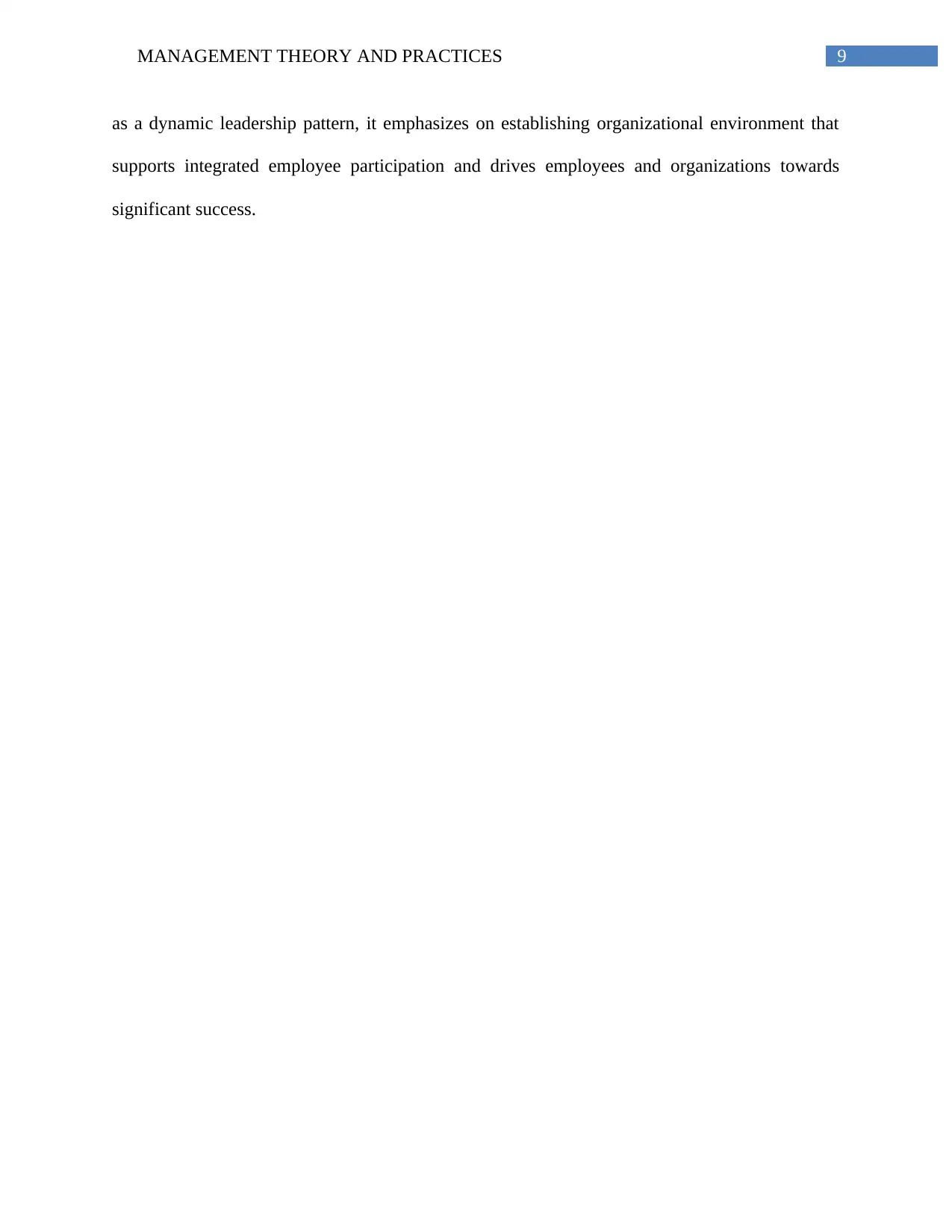
9MANAGEMENT THEORY AND PRACTICES
as a dynamic leadership pattern, it emphasizes on establishing organizational environment that
supports integrated employee participation and drives employees and organizations towards
significant success.
as a dynamic leadership pattern, it emphasizes on establishing organizational environment that
supports integrated employee participation and drives employees and organizations towards
significant success.
Secure Best Marks with AI Grader
Need help grading? Try our AI Grader for instant feedback on your assignments.

10MANAGEMENT THEORY AND PRACTICES
References
Barrick, M.R., Thurgood, G.R., Smith, T.A. and Courtright, S.H., 2015. Collective
organizational engagement: Linking motivational antecedents, strategic implementation, and
firm performance. Academy of Management journal, 58(1), pp.111-135.
Bedford, D.S., 2015. Management control systems across different modes of innovation:
Implications for firm performance. Management Accounting Research, 28, pp.12-30.
Bennett, W.L., Segerberg, A. and Knüpfer, C.B., 2018. The democratic interface: Technology,
political organization, and diverging patterns of electoral representation. Information,
Communication & Society, 21(11), pp.1655-1680.
Berger, A.A., 2017. Political parties: A sociological study of the oligarchical tendencies of
modern democracy. Routledge.
Bolman, L.G. and Deal, T.E., 2017. Reframing organizations: Artistry, choice, and leadership.
John Wiley & Sons.
Christensen, T., Lægreid, P., Roness, P.G. and Røvik, K.A., 2014. Organization theory and the
public sector: Instrument, culture and myth. Routledge.
Daft, R.L., 2014. The leadership experience. Cengage Learning.
Lawson, A., 2015. What difference has a year under new leadership made for Tesco?. Available
from https://www.independent.co.uk/news/business/analysis-and-features/what-difference-has-a-
year-under-new-leadership-made-for-tesco-10473953.html Accessed on 13 December 2018.
Moorhead, P., 2018. Cisco's 'People Deal' Exemplifies Its Cutting Edge Commitment To
Employees. Available from https://www.forbes.com/sites/patrickmoorhead/2018/08/08/ciscos-
people-deal-exemplifies-its-cutting-edge-commitment-to-employees/ Accessed on 13 December
2018.
References
Barrick, M.R., Thurgood, G.R., Smith, T.A. and Courtright, S.H., 2015. Collective
organizational engagement: Linking motivational antecedents, strategic implementation, and
firm performance. Academy of Management journal, 58(1), pp.111-135.
Bedford, D.S., 2015. Management control systems across different modes of innovation:
Implications for firm performance. Management Accounting Research, 28, pp.12-30.
Bennett, W.L., Segerberg, A. and Knüpfer, C.B., 2018. The democratic interface: Technology,
political organization, and diverging patterns of electoral representation. Information,
Communication & Society, 21(11), pp.1655-1680.
Berger, A.A., 2017. Political parties: A sociological study of the oligarchical tendencies of
modern democracy. Routledge.
Bolman, L.G. and Deal, T.E., 2017. Reframing organizations: Artistry, choice, and leadership.
John Wiley & Sons.
Christensen, T., Lægreid, P., Roness, P.G. and Røvik, K.A., 2014. Organization theory and the
public sector: Instrument, culture and myth. Routledge.
Daft, R.L., 2014. The leadership experience. Cengage Learning.
Lawson, A., 2015. What difference has a year under new leadership made for Tesco?. Available
from https://www.independent.co.uk/news/business/analysis-and-features/what-difference-has-a-
year-under-new-leadership-made-for-tesco-10473953.html Accessed on 13 December 2018.
Moorhead, P., 2018. Cisco's 'People Deal' Exemplifies Its Cutting Edge Commitment To
Employees. Available from https://www.forbes.com/sites/patrickmoorhead/2018/08/08/ciscos-
people-deal-exemplifies-its-cutting-edge-commitment-to-employees/ Accessed on 13 December
2018.
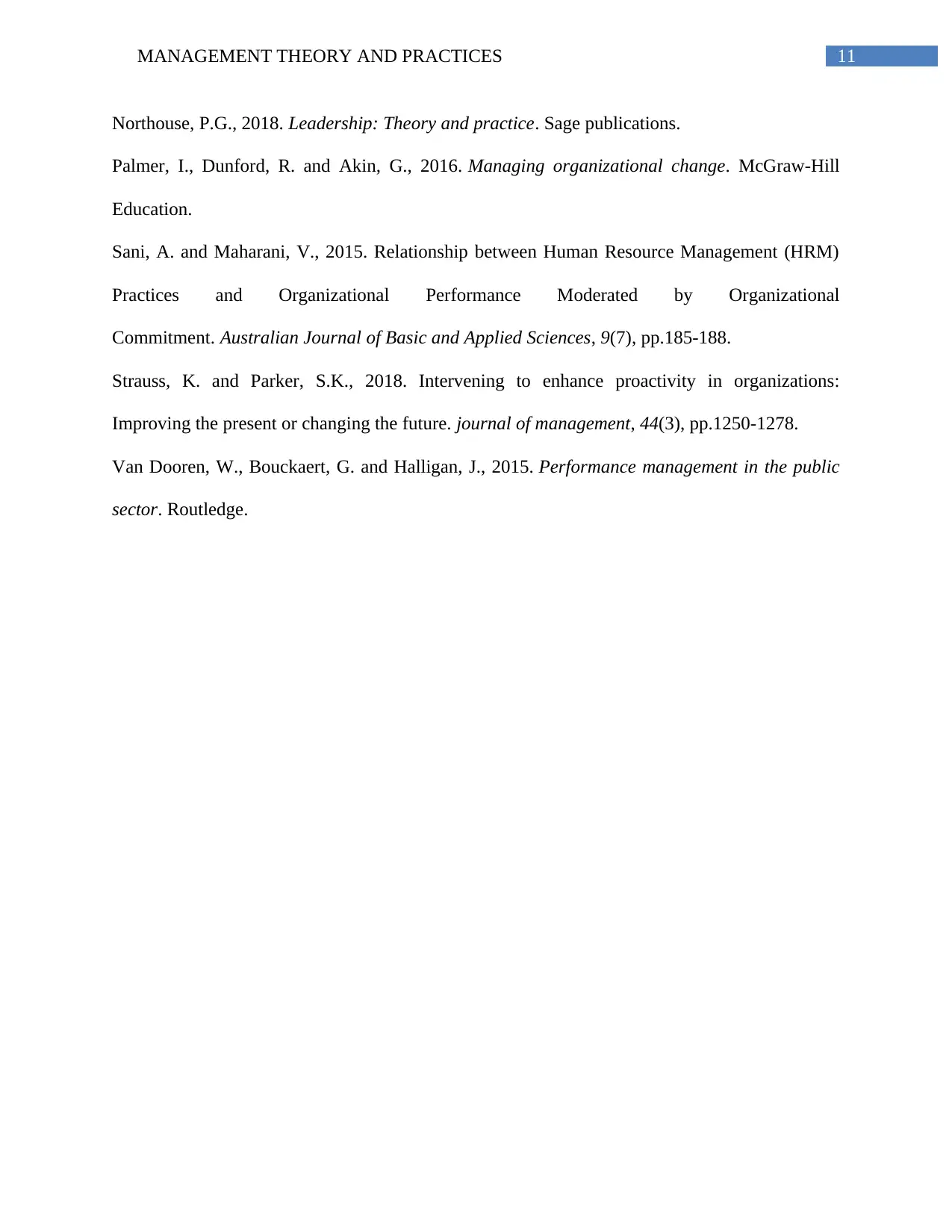
11MANAGEMENT THEORY AND PRACTICES
Northouse, P.G., 2018. Leadership: Theory and practice. Sage publications.
Palmer, I., Dunford, R. and Akin, G., 2016. Managing organizational change. McGraw-Hill
Education.
Sani, A. and Maharani, V., 2015. Relationship between Human Resource Management (HRM)
Practices and Organizational Performance Moderated by Organizational
Commitment. Australian Journal of Basic and Applied Sciences, 9(7), pp.185-188.
Strauss, K. and Parker, S.K., 2018. Intervening to enhance proactivity in organizations:
Improving the present or changing the future. journal of management, 44(3), pp.1250-1278.
Van Dooren, W., Bouckaert, G. and Halligan, J., 2015. Performance management in the public
sector. Routledge.
Northouse, P.G., 2018. Leadership: Theory and practice. Sage publications.
Palmer, I., Dunford, R. and Akin, G., 2016. Managing organizational change. McGraw-Hill
Education.
Sani, A. and Maharani, V., 2015. Relationship between Human Resource Management (HRM)
Practices and Organizational Performance Moderated by Organizational
Commitment. Australian Journal of Basic and Applied Sciences, 9(7), pp.185-188.
Strauss, K. and Parker, S.K., 2018. Intervening to enhance proactivity in organizations:
Improving the present or changing the future. journal of management, 44(3), pp.1250-1278.
Van Dooren, W., Bouckaert, G. and Halligan, J., 2015. Performance management in the public
sector. Routledge.
1 out of 12
Related Documents
Your All-in-One AI-Powered Toolkit for Academic Success.
+13062052269
info@desklib.com
Available 24*7 on WhatsApp / Email
![[object Object]](/_next/static/media/star-bottom.7253800d.svg)
Unlock your academic potential
© 2024 | Zucol Services PVT LTD | All rights reserved.





